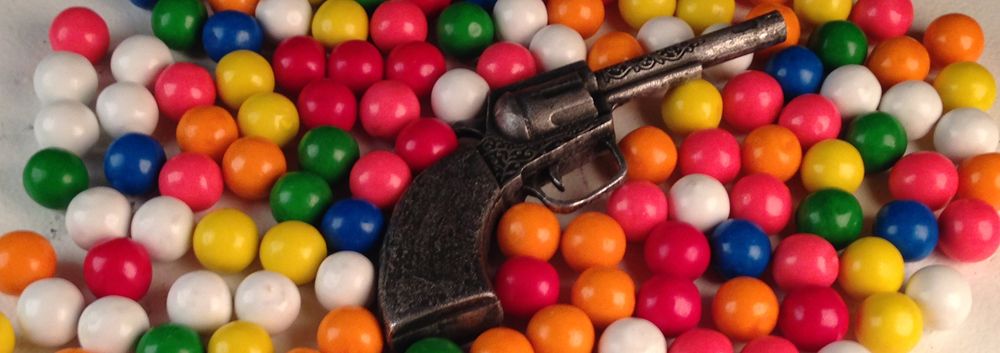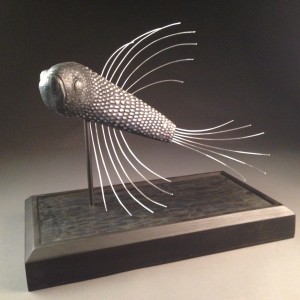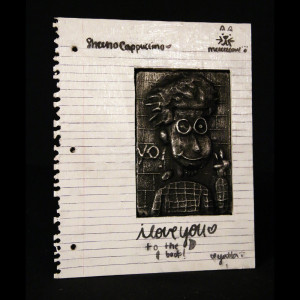Mission: (Project Description)
In this project the student will learn the process of developing a metal casting using a two-part sand resin bond mold. The first part of the project will be to create a pattern using a variety of methods and materials. Mixing sand and resins the student will create a mold. The mold will be used to create a void to be poured in metal. The metal sculpture will then be finished accordingly. The student will be graded by keeping schedule with the processes of the assignment as well as the finished form. Keep up, so you do not fall behind.
Sketchbook Assignment:
Sketches of your ideas should be rendered before and during sculpting. A minimum of five pages should be dedicated to this sketching component. In addition, find a minimum of four cast sculptures or objects that inspire you. Printed images of these sculptures or objects should be placed in your sketch book. Your sketch book will be graded along with your project.
Project Tasks:
Metal casting: Create a metal casting using an original student created pattern and a multi-part sand-resin bond mold.
- Form: Create a pattern, Open to individual concepts.
- Surface: Form should have at least two textures that create balance in the form and surface, yet contrast significantly.
- Movement: Form and surface should draw the viewer around the form
- Multi-Part mold: Using the pattern, sand-resin bond will be used to create the components of the sand mold. Gating: A gating system will be carved into the mold parts to allow metal to be poured into the cavity left by the pattern.
- Yoke: Create a yoke system for the mold.
- Casting: Pour the sculpture in metal.
- De-gating and Metal finishing: Prepare the form for patina.
- Patina/Surface Treatment: Patina or dye-oxide
- Sealant: Seal the finished form.
Pattern Note:
Create a pattern using a material that will pull out of your mold: clay, wood, paper, styrofoam and many other materials may be used. Your pattern should be well crafted. Create a draft in your pattern so it pulls from the mold more easily.
Pattern dimensions should be approximately 4.5 x 8 x 2 inches. This is the smallest dimension. Due to material availability consult the instructor before executing larger forms. Realize… the larger the form, the larger the mold, equals more work and material cost.
Wood Shop Note:
Before cutting any materials in the wood shop, Make sure all staples and metals are removed from the material. Make an extra effort to affirm that no screws or nails remain in purchased or reclaimed materials.
Group Participation:
• Mold Making: Group Engagements: There will be several Sand Parties to create the “Sand-Resin Bond” molds. This will be a class endeavor, where sand and chemicals will be mixed and rammed at the same time to reduce waste. Absence or lack of participation during these events will have an effect your grade. Excess sand from this process should be promptly rammed into Scratch block molds.
• Metal Casting: Group Engagement: The form will be cast in metal using the foundry. Casting crews and task will be designated. Attendance and participation offer much to the experience. Absence or lack of participation during these events will have an effect your grade.
Wear appropriate clothing during foundry pours.
• Cotton clothing, pants and shirt.
• Leathers or Fire resistant suits
• Safety Glasses
• Safety shield
• Hard Hat-welding cap
• Leather covered shoes (Steel toed preferred)
• Leather chaps or leggings
• Leather spats
• No Poly blends, No Pleather: These can be extremely flammable near the pouring activities.
Tools and Materials:
• Sketch Book
• Dust Mask/Particulate Respirator
• Safety Glasses
• Protective clothing: Leathers
• Materials for pattern
• Mold materials
• Sand
• Sand resin chemicals
• Wood
• Wood Shop
• Metal: Aluminum, Bronze, Iron
• Casting Foundry/Furnace
• Rubber or Latex gloves
• Welding Eye Protection
• Welding Gloves
• Angel Grinder
• Grinding disc
• Cut off disc
• Flap Disc
Type of facilities and furnace will designate what casting metals will be used.
Create a label for your project with these specifics:
• Name:
• Dimensions: HWD
• Materials:
• Metal casting weight:
• Year Complete:
• Course:
Tape your label to your project. Use masking tape so that it will not harm your project.
Objectives:
- Method: Planning, Cutting Safely, Building techniques and strategies
- Material Characteristics:
- Three-Dimensional Pattern Making
- Mold Making Process: Cope and Drag
- Volume: HWD
- Mold Gating/Sprue Methods
- Hot Metal Casting Process
- Successful Casting
- Fabrication techniques: Post Casting fabrication, Object Installation
- Structural and Aesthetic qualities
- Finishing Techniques: Heat Treated Patina
- Sensibility to form: Good design, clean aesthetics
- Integrity of the artist to their craft
Caution:
Chemicals and fumes: This process uses chemicals and materials that might be dangerous for some people. Read the MSDS (Material Safety Data Sheet) for questionable materials. Please use a respirator and rubber or latex gloves while using chemicals and chemically treated sand. A dust mask may be used rather than a respirator. The respirator will provide better protection.
Foundry: This project will incorporate the use of the foundry and “Extremely Hot Metal”. Safety and a disciplined studio etiquette should be followed during metal pours and all studio activities.
Research and Inspiration:
- Barbara Hepworth
- Lynn Chadwick
- Rachel Whiteread
- Tony Cragg
- Henry Moore
- Constantine Brancusi
- Magdalena Abakanowicz
- Hanneke Beaumont
- Larry R. Rankin
- Pam Brown
- Gerry Masse
- Jim Wade
- Nate Goodman
- Alexander Archipenko
- Naum Gabo
- Deepak Paunikar
- Sculpture Trails: Outdoor Museum
- SLOSS Furnaces




